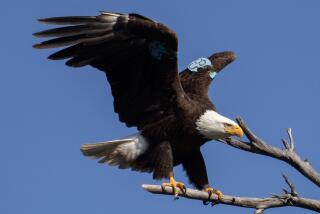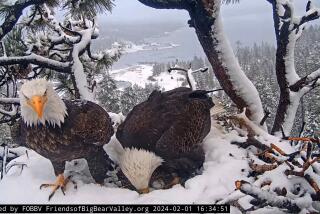Eaglets Returned to Channel Islands
Fifty years after pollution drove them off, bald eagles were returned to Channel Islands National Park on Monday, marking the first step in a five-year effort to restore the powerful predators to the sanctuary.
The four eaglets, with their 9-foot wingspans and enormous yellow talons, shivered as they were carried up a ladder in driving rain and placed in locked nesting boxes on Santa Cruz Island. They flapped and squawked before gazing out at the dramatic seascapes, jagged mountains and hidden coves that biologists hope will be their new home.
A month from now, when the birds can fly, the boxes will be opened and they will be released.
“Returning bald eagles to the Channel Islands is the ecological equivalent to restoring wolves to Yellowstone Park,” said park Supt. Tim Setnicka. “It’s that significant.”
Scientists and park officials hope the bald eagles, which left the islands after DDT poisoning thinned their eggshells, will again dominate the sky, driving off the golden eagles that eat the island foxes. The foxes have been penned for their safety and won’t be released until the golden eagles are gone.
The project’s funding comes from a $140-million settlement reached in 2000 between the government and the Montrose Chemical Corp. and other companies. The businesses were accused of dumping millions of pounds of toxic DDT and PCBs into the ocean near Los Angeles from 1947 until 1972. The chemicals poisoned fish, mammals and birds such as the bald eagle. Wildlife agencies, which say 110 tons of the poisons remain in the ocean, are using $30 million of the settlement to restore what was lost.
The 8-week-old eaglets, which came from the San Francisco Zoo, will be monitored with cameras in their nest boxes and with satellite transmitters attached to their bodies.
They will be fed pig carcasses for a month after their release to keep them healthy until they can hunt their own food.
“When they are released there will be some mistakes made,” said David Garcelon, president of the Institute for Wildlife Studies in Arcata, which monitors and helps manage the eagles. “Landing is a tough thing to learn how to do. And it takes about a year before they can take fish from the water surface.”
The eaglets’ perch on an 800-foot hill overlooking Chinese Harbor will get the updrafts needed when they decide to fly.
“They will grow from something young and gawky, and in four weeks they will be dominating the skies,” Garcelon said.
That’s what park officials are banking on.
When the bald eagle disappeared half a century ago, the vacuum was filled by the golden eagle, a voracious hunter that arrived in the late 1980s. The eagles, which are not native to the islands, fed on the thousands of feral pigs and a handful of island foxes. Plans are now underway to fence in the pigs and shoot them next year. The park hopes eliminating the food source and restoring bald eagles--which do not feed on foxes--will rid the islands of the golden eagles.
“We have a system out of balance because of nonnative species,” Setnicka said. “This restoration ecology is like medicine was at the turn of the century, and we are still groping in the dark.”
No one knows if the new bald eagles will hunt, breed or even stay on the islands. There is also no guarantee that any of their eggs will hatch.
In 1980, bald eagles were restored to Santa Catalina Island but the effects of the DDT have lingered, with only 30% of the eggs laid actually hatching into chicks. Catalina now has 20 bald eagles and four breeding pairs, biologists said.
“When an eagle lays an egg on Catalina we swipe them and switch them with a phony egg,” said Peter Sharpe, a wildlife ecologist who helped bring the birds back to Catalina. “We take the egg to the San Francisco Zoo.”
When an egg hatches, the chick is put in the nest in the hope that the parents will take care of it. So far, the practice has been largely successful, with the exception of one mother who pecked her chick to death.
Most of the bald eagles on Catalina have stayed but they often wander far and wide. Radio transmitters have recorded them in Oregon and British Columbia.
The Santa Cruz eagles will be joined by eight others from Alaska later this year. Setnicka said he would like to have about 50 within five years.
Biologist Jessica Dooley will monitor the eaglets on the 65,000-acre Santa Cruz Island, the largest in the Channel Islands chain.
“Once they begin to fly, it’s a critical time,” she said. “They will need to find food.”
Dooley carried the eagles up a slippery 15-foot ladder to their boxes. She put two birds in each of the large nests made of logs and straw. The raptors glared and occasionally hissed at the humans surrounding them.
The wind blew cold rain through the metal bars of the box. The eaglets shielded themselves with their big black wings. Because they are young, their heads don’t have the signature white feathers that characterize adult bald eagles.
Garcelon looked up at the blocky tower with its boxes and sweeping vistas of mountain ridges and deep blue ocean.
“There is probably nothing more rewarding than returning a species to its habitat,” he said, “And returning eagles to their former grandeur.”
More to Read
Sign up for Essential California
The most important California stories and recommendations in your inbox every morning.
You may occasionally receive promotional content from the Los Angeles Times.










